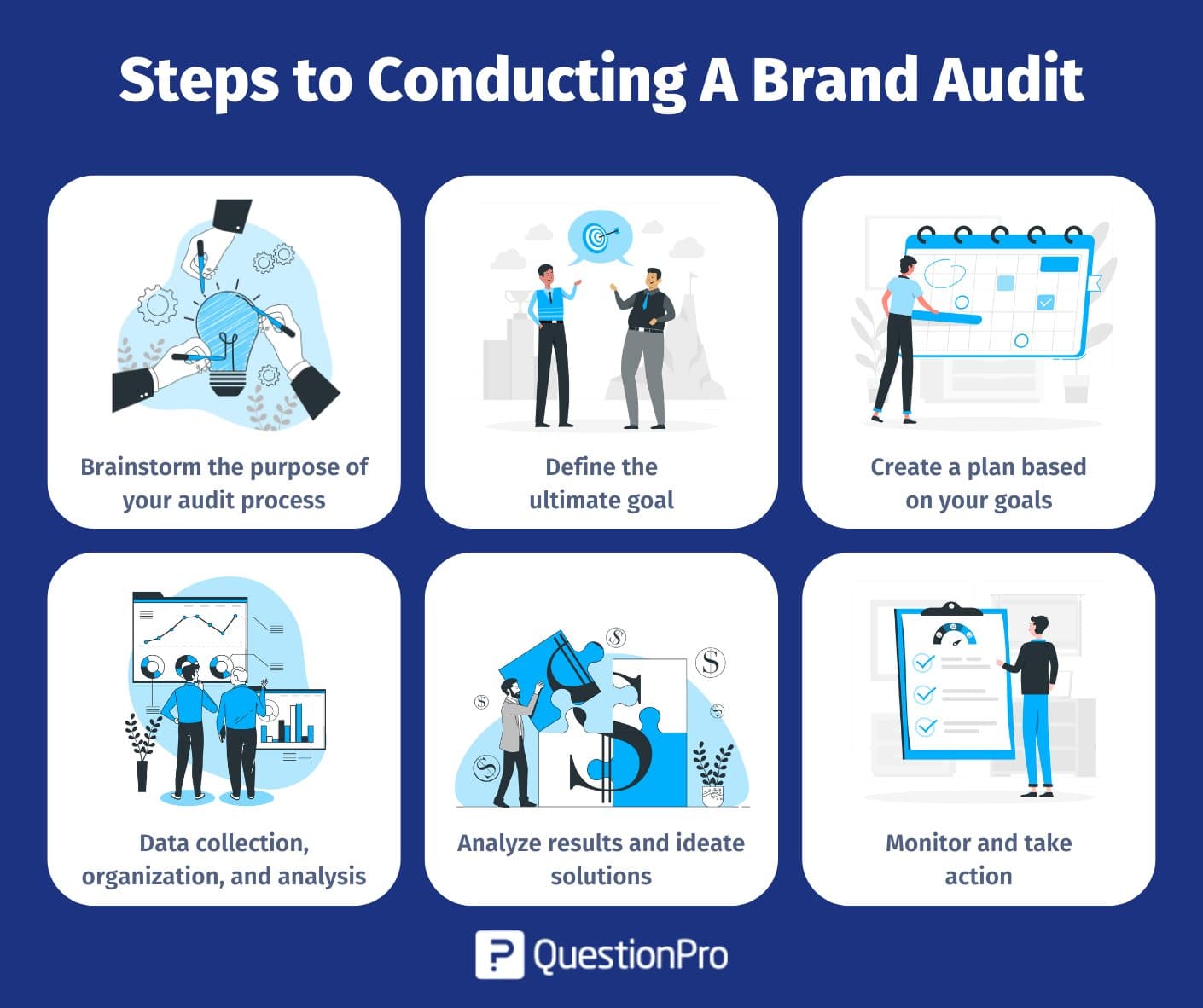
Your most important resource is your brand. A brand audit helps companies evaluate their internal and external branding through customer surveys, data analysis, and a competition review.
An effective brand represents a company’s vision, mission, and personality; these elements work best together when they are evident to the customer. But occasionally, a brand needs to be analyzed to see whether and where it needs to change. That is why it’s important to do a brand audit.
So, if you are thinking about conducting brand audits, go for it. In this post, we explain it and show you a step-by-step guide to conducting one.
What is a brand audit?
A brand audit is a comprehensive look at every part of a brand, such as its history, mission, vision, values, target markets, products and services, marketing mix, and the landscape of its competitors.
It is a way for a company to figure out how its brands or products are positioned in the markets it serves. Brand positioning includes both how your brand fits into the market as a whole and how a customer knows or remembers it.
When you do an audit, you can step back and look at the bigger picture, which can help you develop a long-term plan.
What is the importance of conducting a brand audit?
A successful brand audit results in an action plan that points out where you can improve. This plan should include your goals and a timeline for when you expect to see results.
Conducting a brand audit helps you stay current and ahead of your competitors. It gives you important information about your business. Since the business world is always changing, it’s important to make brand audits a regular practice. Here are several important reasons to conduct a brand audit:
- Identify Strengths and Weaknesses: A brand audit helps you see what your brand is good at and where it needs to get better. This thorough review looks at all parts of your brand, both online and offline.
- Enhance Brand Awareness: By conducting a brand audit, you can find ways to make it more recognizable. When more people know about your brand, sales and customer loyalty often increase.
- Improve Customer Loyalty and Retention: A strong brand keeps customers coming back. A brand audit can show why customers prefer your brand and stay loyal.
- Cost-Effective Marketing: Brands with a strong presence spend less on getting new customers. An audit can make your marketing efforts more efficient and save you money.
- Crisis Resistance: A brand audit can help you understand your brand’s weak points. You can plan to reduce risks and handle crises more effectively.
- Boost Return on Investment (ROI): Improving your brand leads to better financial results. Finding ways to make your brand stronger can increase your market share and profits.
- Customer Advocacy: Happy customers are more likely to recommend your brand to others. This is customer advocacy. A brand audit can help you find ways to increase customer satisfaction and turn them into advocates for your brand.
LEARN ABOUT: Brand Health
6 Steps to conducting a brand audit
If you’re wondering how to audit brands, the following checklist will walk you through the steps necessary to create brand audits that work best for your company.

Step 01: Brainstorm the purpose of your audit process.
When performing a brand audit, the first step is brainstorming what needs to be examined. It could be your website or your social media performance.
Think about your mind map as an audit questionnaire. It will be the basis of your brand audit framework and will help you find the right information.
Here are some questions to consider when brainstorming with your team:
- What do users discover when they use search engines to look up our brand?
- Is our website user-friendly and conversion-friendly?
- Is our logo truly representative of us?
- What do people think of our brand? Do our customers strongly recommend us?
Step 02: Define the ultimate goal
It’s time to establish some brand goals once you’ve identified the issues or areas of improvement for your company.
Goals can be broad and broad-reaching or narrow and specific, depending on your goal. Whatever it is, decide what you want from the brand audit and get organized.
It is the section of your audit where you note what isn’t working for your brand. Sometimes, the process is straightforward, and you will recognize what needs to be done immediately. In other cases, you will have to try several solutions before settling on the best one.
Step 03: Create a plan based on your goals.
In this step, you need to create a strategy for your brand. If necessary, you should make a checklist to follow with your team or on your own.
It is also a good idea to add different levels to your checklist, like one main list with tasks that stem from it. Assign tasks to team members and explain how to complete them if necessary.
Setting deadlines for various tasks is another aspect of your strategy and planning step. Make a table or a Gantt chart to keep your team organized and focused.
Step 04: Data collection, organization, and analysis
It’s time to start gathering information for your brand audit. Create your own questions and leave enough space to take notes and data.
You should also create a survey to distribute to your customers and people who have heard of your brand but aren’t customers.
QuestionPro is a complete survey software and an easy-to-use platform that lets you survey in minutes. They have a variety of survey formats, such as text responses, multiple choice, and yes/no questions.
They also provide a live poll tool to know your customers’ thoughts instantly. Additionally, the Net Promoter Score (NPS) of QuestionPro allows you to find valuable data about your customers.
This stage may take time, depending on how much data you need to collect and how many people are working on it.
Step 05: Analyze results and ideate solutions.
Now that you have collected and organized the data, it’s time to analyze the brand audit findings to devise appropriate solutions. The next step is to consider solutions to your brand’s problems.
If you’re conducting the audit independently, you may need assistance. Ideation is complex on its own. It would help if you had someone to brainstorm with.
Consider everything you learned during the brand audits and do an ideation and brainstorming session with your team. Remember the three important areas we discussed earlier:
- Internal branding
- External branding
- Customer experience
How do these relate to the data you collected through surveys and research? From those data, you’ll notice the strengths and weaknesses of your brand. Make two main lists of your strengths and weaknesses. Consider how your brand’s strengths can help it overcome its weaknesses.
Step 06: Monitor and take action.
In the final step, you need to decide which of the marketing ideas on your list are the simplest and fastest to implement. Start implementing changes and keep an eye out for any changes in ROI, brand awareness, conversions, and customer feedback.
Areas of brand audit
The brand audits look at data to find out how your company can improve the positioning and performance of its brand. It looks at the three areas listed below.
01. Internal branding
Internal branding focuses on aligning your company culture and internal communications with your brand values and goals. This ensures that employees understand and embody the brand, creating a cohesive and consistent brand identity from within the organization. It includes:
- Company culture
- Employee education
- Internal surveys
- Communication channels
02. External branding
External branding involves how your brand is perceived by the public through your marketing efforts and visual identity. This includes:
- Advertisements
- Logos
- Websites
- Email campaigns
- Social media presence
03. Customer experience
Customer experience encompasses all interactions customers have with your brand, from initial contact through post-purchase support. This area evaluates how well these interactions meet customer expectations and enhance their overall perception of the brand. This includes:
- Customer service interactions
- Content engagement
- Sales processes
- Customer support
- Feedback systems
Conducting a Brand Audit with QuestionPro
Conducting a brand audit is important for understanding your brand’s current position and identifying areas for improvement. QuestionPro can make this process easier with its survey and data analysis tools.
First, decide what you want to achieve with your brand audit. Think about which parts of your brand you want to look at, like customer perceptions, brand awareness, or specific marketing efforts. Here’s how you can use QuestionPro for a detailed brand audit:
Step 1: Create Your Surveys
With QuestionPro, creating surveys for your audits is simple. Here’s what you can do:
- Use Templates: Begin with a ready-made template or make your own survey.
- Customize Questions: Add different types of questions like multiple choice, rating scales, open-ended, and Net Promoter Score (NPS).
- Add Branding: Personalize the survey with your logo and brand colors to keep it consistent and professional.
Step 2: Distribute Surveys
QuestionPro provides several ways to share your survey and reach your audience:
- Email Invitations: Send customized survey invites directly to your customers through email.
- Social Media Sharing: Share your survey on social media to connect with a larger audience.
- Website Embeds: Place the survey on your website to gather feedback from visitors.
Make sure your survey works well on mobile devices to get more responses from people using different gadgets.
Step 3: Collect and Organize Data
QuestionPro makes collecting and managing data easy:
- Real-Time Responses: See responses as they come in, allowing you to track progress and make changes if needed.
- Flexible Data Export: Export your data in different formats such as Excel, CSV, or SPSS for more detailed analysis.
Step 4: Analyze Results
Use QuestionPro’s tools to understand your data better:
- Dashboard Visualization: Easily see your data in charts, graphs, and tables using the dashboard.
- Advanced Analytics: Analyze your data deeply with tools for cross-tabulation, trend analysis, and segmentation to find important insights.
- NPS Analysis: Measure customer loyalty and satisfaction with the built-in Net Promoter Score tool.
Step 5: Come up with Ideas and Put Them into Action.
Based on your analysis, think of solutions to address identified issues:
- Collaborative Analysis: Share what you found with your team and come up with ideas to create practical plans.
- Prioritize Actions: Use the insights gained to prioritize the simplest and most impactful changes.
- Monitor Progress: Make the changes and keep an eye on their impact on brand performance with QuestionPro’s real-time feedback tools.
Create thorough reports to clearly communicate what you find during audits:
- Custom Reports: Create custom reports that highlight important insights and recommendations for your audience.
- Shareable Formats: Export reports in various formats for easy sharing with stakeholders.
With QuestionPro’s powerful tools, you can perform a detailed brand audit to learn about your brand’s strengths and weaknesses and create plans to keep getting better.
Conclusion
We hope we have given you a better understanding of a brand audit and how to conduct one. Brand audits are highly beneficial to both brand builders and their customers. Consider it if you are considering rebranding your company or offering services to other companies.
Investigating all aspects of your brand and competitors’ brands will provide invaluable insights into your brand’s market health.
That is why brand audits are worthwhile, as you will walk away with actionable insights. You have to act on them now, and you’ll be on your way to success! If you need help with your audit process, get in touch with QuestionPro.
QuestionPro is a survey software with customer feedback management features that help you manage your customer data and provide real-time statistics to help you with your business insight. Request a free trial to see a demo or learn more.
Frequently Asked Questions (FAQ)
A brand audit is a comprehensive analysis of a brand’s current position in the market compared to its competitors. It evaluates the brand’s strengths, weaknesses, opportunities, and threats by examining both internal and external factors.
A brand audit is important because it helps identify areas for improvement, enhance brand awareness, boost customer loyalty, and make marketing efforts more efficient.
It is recommended to conduct a brand audit at least once a year. However, it may be beneficial to perform an audit more frequently if there are significant changes in the market
The main components of a brand audit include internal branding, external branding, and customer experience. Each component examines different aspects of the brand’s presence and performance.
Tools used in a brand audit can include surveys, focus groups, social media analytics, website analytics, competitive analysis tools, and customer feedback platforms.







